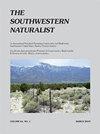LONG DISPERSAL DISTANCES OF THREE MALE BOBCATS IN TEXAS
IF 0.2
4区 环境科学与生态学
Q4 Agricultural and Biological Sciences
引用次数: 0
Abstract
Abstract Dispersal distance of bobcats (Lynx rufus) can be affected by many factors: age and sex, bobcat density, prey abundance, and landscape permeability. Female offspring typically remain near their natal range, whereas males travel farther distances. Studies report dispersal distances between 10 and 85 km, with distances ≥80 km being rare. We report dispersal distances of two male bobcats in the Southern High Plains of Texas, and one male bobcat from the Rio Grande Plains of South Texas. The two male bobcats of Southern High Plains traveled 63 and 133 km and the male bobcat of Rio Grande Plains traveled 100 km. Severe droughts occurred in both regions during dispersal, which may have influenced distance traveled. In all cases, it is likely that nearby available territories were occupied by older resident bobcats, thus eliciting the need for longer-distanced dispersal to secure a permanent home range. Resumen La distancia de dispersión de gatos montés (Lynx rufus) puede ser afectada por muchos factores: la edad y el sexo, la abundancia de los gatos montés, la abundancia de presa y la permeabilidad del paisaje. Las crías hembras típicamente se quedan cerca de su rango de nacimiento, mientras que los machos viajan distancias más lejanas. Estudios han reportado distancias de dispersión entre 10 y 85 km, con distancias ≥ 80 km siendo raras. Reportamos distancias de dispersión de dos gatos montés machos en los Southern High Plains de Texas, y otro gato montés macho del Rio Grande Plains of South Texas. Los dos gatos montés machos de Southern High Plains viajaron 63 km y 133 km, y el otro gato montés macho de Rio Grande Plains viajó 100 km. Durante la dispersión hubo sequías severas en ambas regiones que pueden haber influido en la distancia recorrida. En todos los casos, es muy posible que territorios más cercanos estaban ocupados por otros gatos montés más viejos y residentes, suscitando la necesidad de viajar distancias más lejanas para asegurar un rango de hogar permanente.三只雄性山猫在得克萨斯州的长距离传播
摘要山猫(Lynx Rufus)的分散距离受许多因素的影响:年龄和性别、山猫密度、猎物丰度和景观渗透性。雌性越位通常保持在它们的出生范围附近,而雄性则旅行很远。研究报告说,分散的距离在10至85公里之间,距离≥80公里的情况很少。我们报告说,德克萨斯州南部高平原有两只雄性山猫和德克萨斯州南部格兰德河平原有一只雄性山猫的分散距离。南部高平原的两只雄性山猫行驶了63和133公里,格兰德平原的雄性山猫行驶了100公里。在分散期间,这两个地区都发生了严重的干旱,这可能影响了旅行的距离。在所有情况下,附近可用的领土很可能被老居民山猫占领,因此选择了需要更长距离的分散以确保永久的家园范围。摘要山猫(Lynx Rufus)的散布距离可能受到许多因素的影响:年龄和性别、山猫的丰度、猎物的丰度和景观的渗透性。雌性幼崽通常接近它们的出生范围,而雄性幼崽则走得更远。研究报告说,分散距离在10至85公里之间,距离≥80公里的情况很少。我们报告了德克萨斯州南部高平原两只公山猫和德克萨斯州南部格兰德河平原另一只公山猫的分散距离。南部高平原的两只公山猫旅行了63公里和133公里,格兰德平原的另一只公山猫旅行了100公里。在分散期间,两个地区都发生了严重的干旱,这可能会影响旅行的距离。在所有情况下,最近的领土都很可能被其他更老、更居民的山猫占领,这导致需要走得更远,以确保一个永久的家庭范围。
本文章由计算机程序翻译,如有差异,请以英文原文为准。
求助全文
约1分钟内获得全文
求助全文
来源期刊

Southwestern Naturalist
环境科学-生态学
CiteScore
0.50
自引率
50.00%
发文量
47
审稿时长
18-36 weeks
期刊介绍:
The Southwestern Naturalist (a publication of the Southwestern Association of Naturalists since 1953) is an international journal (published quarterly) that reports original and significant research in any field of natural history. This journal promotes the study of plants and animals (living and fossil) in the multinational region that includes the southwestern United States, Mexico, and Central America. Appropriate submission of manuscripts may come from studies conducted in the countries of focus or in regions outside this area that report significant findings relating to biota occurring in the southwestern United States, Mexico, and Central America. Publication is in English, and manuscripts may be feature articles or notes. Feature articles communicate results of completed scientific investigations, while notes are reserved for short communications (e.g., behavioral observations, range extensions, and other important findings that do not in themselves constitute a comprehensive study). All manuscripts (feature articles and notes) require an abstract in both English and Spanish.
 求助内容:
求助内容: 应助结果提醒方式:
应助结果提醒方式:


